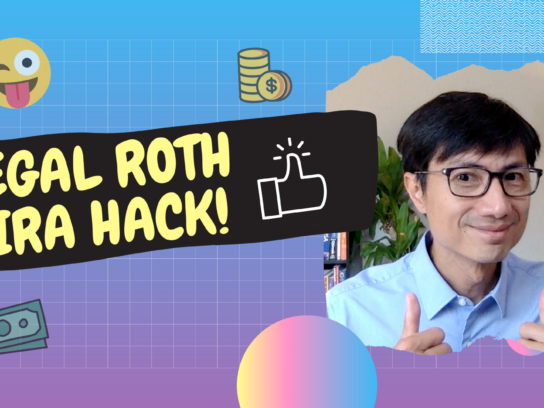
Roth IRAs are a great way to grow money tax-free. However, once you reach a certain income level, you are likely no longer eligible to contribute to a Roth IRA. Luckily, you might be able to take advantage of a tax loophole that came about in 2010. Read on for the steps to create a Backdoor Roth IRA.
Step One: Contribute to a Traditional IRA.
This is pretty straightforward. You can do this through any brokerage firm (Vanguard, Fidelity, etc) as this choice is of no significant impact. You have the option of making the maximum contribution for that year ($6,000 in 2021).
It is crucial to remember that you likely do not want to deduct this contribution from your tax return. If you’re no longer eligible for a Roth, you most likely are also not eligible for a traditional IRA deduction. This is the primary reason people call it a non-deductible traditional IRA.
Step Two: Move your pre-tax IRAs to your current employer plan.
Many people willingly neglect this step, which can lead to a huge tax bill. If you have a rollover IRA that came from an old employer plan (401(k), SEP IRA, etc), it is time to move these to your current employer retirement plan. But do you wonder what that has to do with a backdoor Roth IRA? It has to do with the IRS aggregation rule.
Example: Let’s say you have $95,000 in a rollover IRA. Congratulations on saving that much from your previous job! Now let’s assume you just contributed $5,000 into your new non-deductible traditional IRA. You now have a total of $100,000 in traditional IRA money, 5% of which represents your non-deductible IRA, and 95% of which represents previously tax deducted contributions. Now, if you do a Roth conversion of that $5,000 (you convert this money from traditional to Roth), the IRS will treat it as if you just converted part of your rollover IRA. So, in this example, you just converted 5% of your total IRA money, most of which was tax-deductible when you contributed, so when you convert to Roth, the IRS wants their cut. This could generate an unnecessary tax bill, which we obviously don’t want.
So, consider moving your pre-tax IRAs into your current 401(k) (or another current employer plan). Every employer plan handles this process slightly differently, so you could start by calling your current employer plan company to get the necessary paperwork to start the rollover process.
Step three: Convert your traditional IRA to a Roth IRA
We recommend you consider doing this step at least 12 months from when you contribute to your IRA. The reason for this is because the U.S. Tax Court follows a rule called the Step-transaction Doctrine, which sounds really boring (it is). Essentially this doctrine says that if you do all of these steps by contributing to a Traditional IRA, and then you convert it to a Roth the next day, they will see it as one single transaction. In this case, that would mean you are contributing to a Roth IRA when you are no longer allowed to, and they will slap a penalty on this transaction. You don’t want to risk that! This 12-month rule is not a hard and fast rule. Some advisors think that waiting one month is sufficient, so this is really up to you.
To actually do the Roth conversion can be really simple. In Vanguard, for example, there is a button that says “convert to Roth IRA.” So, you just click on that and follow the instructions. In Fidelity, you have to do some searching. Every brokerage firm will handle it slightly differently, but it should not be an overly difficult process.
Now, when asked about tax withholding, you can choose to not withhold taxes so you have more money going into your Roth IRA when you convert. Once you complete the conversion process, you now have a Roth IRA! You can simply repeat these three steps each year to continue growing tax-free retirement money.
Bonus tip: You might be tempted to brag about creating a Backdoor Roth IRA with your CPA or your parents or your friends. You might not want to mention the word Backdoor Roth IRA in your email or text messages. This is again because of that Step-transaction Doctrine we discussed earlier.



Comments are closed.